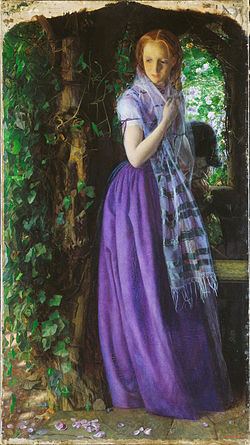Year 1855–1856 Created 1855–1856 Genre History painting | Location Tate Gallery, Britain Media Oil paint | |
 | ||
Dimensions 89 cm × 50 cm (35 in × 19.5 in) Periods Romanticism, Pre-Raphaelite Brotherhood Similar Arthur Hughes artwork, Pre-Raphaelite Brotherhood artwork, Oil paintings | ||
April love painting top 8 facts
April Love is a painting by the Pre-Raphaelite painter Arthur Hughes which was created between 1855 and 1856. It was first exhibited at the Royal Academy of Arts in 1856.
At its first showing Hughes accompanied the painting with an extract from Tennyson's poem "The Miller's Daughter":
Love is hurt with jar and fret,Love is made a vague regret,Eyes with idle tears are set,Idle habit links us yet;What is Love? For we forget.Ah no, no.Originally acquired by William Morris, the painting was purchased by the Tate Gallery, London (now Tate Britain) in 1909 and has remained in the Tate collection to the present day.
It shows a distinctly Pre-Raphelite style in which a soft approach to nature and femininity is found. Bright colors and red-haired women as well as an emphasis on nature and symbolism characterize this style which can be found in the late 1800s as a response to industrialization.
The painting depicts a young couple at a moment of emotional crisis. The male figure is barely visible, his head bent over the young woman's left hand. The woman is looking down at fallen blossoms, suggesting the end of spring, and of early and young love.
The model for the principal figure was Tryphena Ford, whom Hughes married in 1855.
